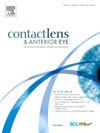265 nm紫外线C光治疗多重耐药铜绿假单胞菌角膜炎的体外和体内实验研究。
IF 3.7
3区 医学
Q1 OPHTHALMOLOGY
引用次数: 0
摘要
背景:本研究评估了1.93 mW/cm2的265纳米(nm)紫外线C (UVC)光对多重耐药(MDR)铜绿假单胞菌(P. aeruginosa)角膜炎的体内外疗效。方法:研究UVC光对两株铜绿假单胞菌临床分离株的影响。分离物1对环丙沙星敏感,分离物2对耐多药敏感(但对头孢他啶敏感)。为进行体外评价,将铜绿假单胞菌(P. aeruginosa)分离物(100 μl, 1*108 CFU/ml)铺于Muller-Hinton固体琼脂表面,UVC光照射1、5、10、15和30秒。体内实验采用铜绿假单胞菌(P. aeruginosa)分离株(5 μL, 1*108 CFU/ml)感染C57BL小鼠右眼,分为分离株1和2两组。第一组(n = 24)随机分为四组:a)未经治疗,b) UVC光照15 s,每日2次,连续2天,c) 0.3% w/v外用环丙沙星,每日2次,连续2天,d) 0.3% w/v外用环丙沙星,每小时2次,连续2天。第二组耐多药铜绿假单胞菌(n = 24)的治疗方法相似,但d组除外(口服头孢他啶5% w/v,每小时2次,持续2天)。用左眼评价不诱导感染的应用方法的安全性。在48小时(hrs),眼睛去核并进行微生物学和组织病理学分析。结果:UVC光在体外暴露15 s和30 s时均有明显的抑制区。结论:265 nm UVC光对铜绿假单胞菌具有暴露依赖性的体外杀菌作用。体内研究表明,UVC光对两株铜绿假单胞菌的杀灭效果相当。本文章由计算机程序翻译,如有差异,请以英文原文为准。
Efficacy of 265 nm ultraviolet C light in the treatment of multi-drug resistant Pseudomonas aeruginosa keratitis in vitro and in an in vivo murine model
Background
This study evaluated the in vitro and in vivo efficacy of 265 nanometer (nm) ultraviolet C (UVC) light using 1.93 mW/cm2 against multi-drug-resistant (MDR) Pseudomonas aeruginosa (P. aeruginosa) keratitis.
Methods
The effect of UVC light was studied on two clinical isolates of P. aeruginosa. Isolate 1 was ciprofloxacin-susceptible, and isolate 2 was MDR (but ceftazidime-susceptible). For the in vitro evaluation, P. aeruginosa isolates (100 μl, 1*108 CFU/ml) were spread on Muller-Hinton solid agar surface and exposed to UVC light for 1, 5, 10, 15, and 30 seconds (s). For the in vivo study, the right eyes of C57BL mice were infected with the P. aeruginosa isolates (5 μL, 1*108 CFU/ml) in two sets with isolates 1 and 2, respectively. The first set (n = 24) was randomized into four groups: a) untreated, b) UVC light 15 s exposure twice daily for two days, c) topical ciprofloxacin 0.3 %w/v twice daily for two days, d) topical ciprofloxacin 0.3 %w/v two-hourly for two days. The second set with MDR P. aeruginosa (n = 24) was treated similarly except for group d (which received topical ceftazidime 5 %w/v two hourly for two days). The left eyes were used to evaluate the safety of applied treatments without inducing infection. At 48 hours (hrs), eyes were enucleated and subjected to microbiological and histopathology analysis.
Results
In vitro, the UVC light exposure resulted in a clear inhibition area for exposures of 15 and 30 s. In the in vivo murine model, UVC light prevented overall clinical severity (p < 0.05) at 24 and 48 hrs by both isolates. Microbiological assessment at 48 hrs showed no growth of organisms in UVC light-treated corneas of either of the sets, similar to an observed treatment with ciprofloxacin (set 1) and ceftazidime (set 2).
Conclusion
265 nm UVC light showed an exposure-dependent in vitro bactericidal effect on P. aeruginosa. The in vivo studies showed that UVC light eliminated both strains of P. aeruginosa with an equivalent efficacy.
求助全文
通过发布文献求助,成功后即可免费获取论文全文。
去求助
来源期刊

Contact Lens & Anterior Eye
OPHTHALMOLOGY-
CiteScore
7.60
自引率
18.80%
发文量
198
审稿时长
55 days
期刊介绍:
Contact Lens & Anterior Eye is a research-based journal covering all aspects of contact lens theory and practice, including original articles on invention and innovations, as well as the regular features of: Case Reports; Literary Reviews; Editorials; Instrumentation and Techniques and Dates of Professional Meetings.
 求助内容:
求助内容: 应助结果提醒方式:
应助结果提醒方式:


